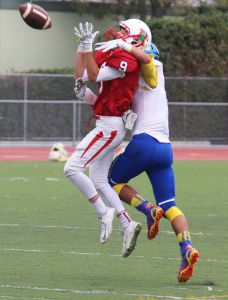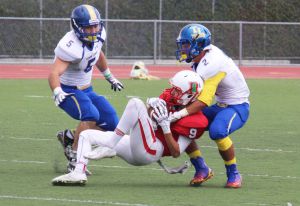One inch higher, and senior Kevin Reis would have spent the rest of his life paralyzed, likely watching his former teammates from a wheelchair. Instead, Reis has now returned to the football field after a multi-year recovery from a fractured vertebra.

“I put my head down during a special teams drill. I took four steps and just felt my whole spine, my whole body start tingling,” Reis said of the injury he suffered in the fall of 2011.
Reis faced a blocker head-on during the freshman football team’s practice. As his helmet hit the player’s chest, Reis’ head compressed and bent downward, causing his spine to absorb the force of the hit.
Reis continued to sprint a few steps until the adrenaline wore off, and suddenly he felt the pain weigh him down. He hit the turf in shock.
“I went to the ground and threw off my helmet,” Reis said. “I couldn’t feel anything in my body. I just started screaming.”
An ambulance rushed onto the football field and transported Reis to Marin General Hospital, where he remained until he was taken to the University of California, San Francisco Hospital’s Pediatric Intensive Care Unit early the next morning.
An MRI indicated that Reis had suffered a compression fracture in the sixth thoracic vertebra (T6), located just below the shoulder blades, one of the 12 thoracic vertebrae that run from the neck to the lower back.
After the injury, Reis wore a back brace for seven months and underwent physical therapy, cutting back on his physical activity during that time.
Doctors recommended that Reis not play contact sports again, and, at the time, Reis wasn’t eager to step back on the field either.
“I thought I would never play again,” he said. “And I didn’t want to. I thought it wasn’t worth it.”
However, last spring, teammates encouraged Reis to try out for wide receiver, as the team lacked depth in this position. After spending some time on the field again with friends and coaches, there was no looking back for Reis.
Through the first eight games this season, Reis has caught 29 passes for 483 yards and six touchdowns. He is the leading receiver for the resurgent Giant varsity squad this year, a team hoping to qualify for the North Coast Section (NCS) playoffs for the first time since the 2008 season.
As traumatic as the injury was, and as lengthy as the rehabilitation took, a full recovery was never out of the question—even though doctors recommended he should never play football again.
According to Dr. Robert Byers, a spine surgeon at Mt. Tam Orthopedics in Larkspur who has treated all types of spine conditions and injuries, it is uncommon for an injury like Reis’ to have serious consequences after a successful recovery.
“The good news is that usually those fractures are not functionally threatening. In other words, it’s rare for those to actually cause paralysis,” Byers said.
That being said, Byers acknowledged the level of pain involved, as well as the likelihood of a lengthy recovery like the one Reis experienced.
However, had Reis’ T6 vertebra been compressed to a certain extent there would have been long-term repercussions.
“If he suffered a fracture and it compressed the vertebral bone more than 50 percent, that would put the adjacent vertebrae at increased risk of a fracture going forward,” Byers said.
In order to prevent spine injuries, Byers emphasized that core strength is paramount.
“The only thing that people can do to lessen the likelihood of a back injury playing football is to have a stronger core,” he said. “The theory is that the stronger the muscles are, the less stress gets applied to the spine itself.”
As a result of the public’s growing concern regarding youth concussions and football injuries, new California law is scheduled to take effect on Jan. 1, 2015. Full-contact practices in high school will be limited to two 90-minute sessions per week.
The Redwood football team has only one full-contact practice a week in which players dress in full game padding.
“Two 90-minute sessions, to me, is crazy, going out there and banging heads for 90 straight minutes,” said varsity head football coach Corky Henderson. “Honestly, you don’t need a ton of hitting, bodies on bodies.You don’t want your injuries coming when you’re practicing against each other.”
Athletic trainer Americ Alvarado believes that the new law will be a good first step to address this issue, but does not think it will accomplish as much as some may hope.
“In practicality, it doesn’t make sense for the sport because you’re going to have to hit anyways,” he said. “So by limiting hitting, it doesn’t mean you’re limiting concussions. It’s not the amount of hits, it’s more the force of the hits.”

Considering the precautions that the football program already takes in terms of preventing injuries from contact, Redwood seems ahead of the curve. However, Reis believes the injury he sustained was avoidable.
While he takes responsibility for his role in the accident that caused his injury, he believes first-time high school football players should undergo a more thorough training process to learn how to tackle safely.
Reis played youth football for one year before joining the freshman team at Redwood, but many of his teammates had never played organized tackle football before. Reis said that many of his freshmen teammates made the dangerous mistake of approaching tackles by leading with their heads.
In Reis’ opinion, the risks of the game could be reduced if football players were trained more extensively. He recognizes that actions being taken to limit the quantity of full-contact practices can be helpful when it comes to the safety of high school football players, but points out that it is not just the amount of practice that needs to be modified, but rather the quality of instruction.
“The players are just thrown out there to tackle each other [without sufficient training],” Reis said.










